The Vaporizers Market is estimated to be valued at USD 41.9 billion in 2025 and is projected to reach USD 495.2 billion by 2035, registering a compound annual growth rate (CAGR) of 28.0% over the forecast period.
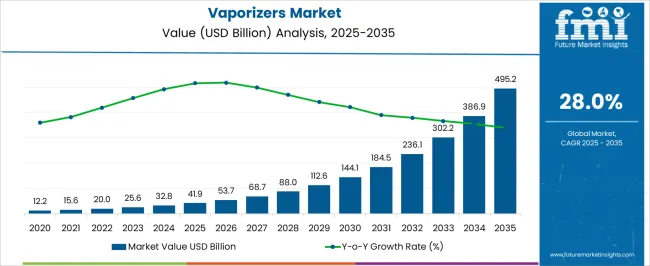
| Metric | Value |
|---|---|
| Vaporizers Market Estimated Value in (2025 E) | USD 41.9 billion |
| Vaporizers Market Forecast Value in (2035 F) | USD 495.2 billion |
| Forecast CAGR (2025 to 2035) | 28.0% |
The vaporizers market is undergoing rapid expansion as consumer interest in smoke-free alternatives rises across wellness, recreational, and medical use cases. Innovations in thermal control, battery efficiency, and device ergonomics have redefined user expectations, driving adoption across multiple price tiers.
Increased awareness about the health implications of combustion-based consumption methods has further supported the shift toward vaporization technology. Brands are focusing on integrating smart features such as temperature customization, mobile connectivity, and modular components, all of which enhance the user experience and product longevity.
Additionally, the legalization of cannabis in several regions and the evolving perception of aromatherapy and herbal remedies have opened new revenue channels for vaporizer manufacturers. With consumers seeking premium, discreet, and portable consumption solutions, the market is expected to remain on an upward trajectory, particularly in regions that are expanding their regulatory frameworks and wellness infrastructure.
The market is segmented by Product Type, Heating Methods, Price, Consumable Type, Heat Up Time, and Sales Channel and region. By Product Type, the market is divided into Portable, Pen Style, Regular Size, Desktop, Whip Style, Forced Air, E-Nail, and Multifunctional. In terms of Heating Methods, the market is classified into Conduction and Convection. Based on Price, the market is segmented into Premium and Economy/Mid-Range. By Consumable Type, the market is divided into Dry herb, Concentrates, and Others. By Heat Up Time, the market is segmented into 10 seconds or less, 20-60 seconds, and 2-4 minutes. By Sales Channel, the market is segmented into Online and Offline. Regionally, the market is classified into North America, Latin America, Western Europe, Eastern Europe, Balkan & Baltic Countries, Russia & Belarus, Central Asia, East Asia, South Asia & Pacific, and the Middle East & Africa.
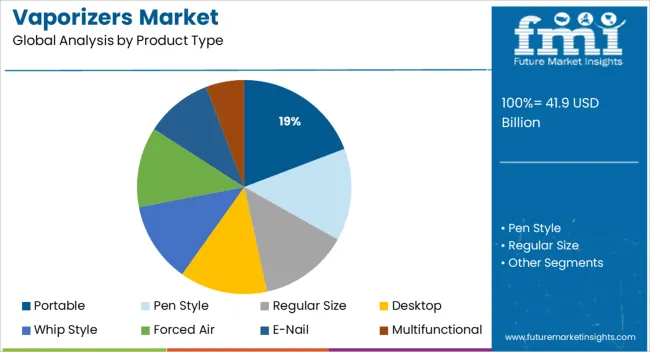
The portable product type segment is expected to account for 19.2% of overall revenue in 2025, establishing it as a key growth driver within the vaporizers market. This share is supported by rising demand for compact, travel-friendly devices that cater to on-the-go lifestyles and personal wellness routines.
Portability is increasingly prioritized among users who seek convenience without compromising functionality, prompting manufacturers to innovate on battery life, chamber size, and discreet form factors. The surge in demand from recreational and medicinal users alike has further validated the commercial potential of portable vaporizers.
Continued focus on improving heat-up time, ergonomic design, and intuitive interfaces is ensuring sustained interest, particularly in urban markets where mobility and discretion are crucial purchase factors.
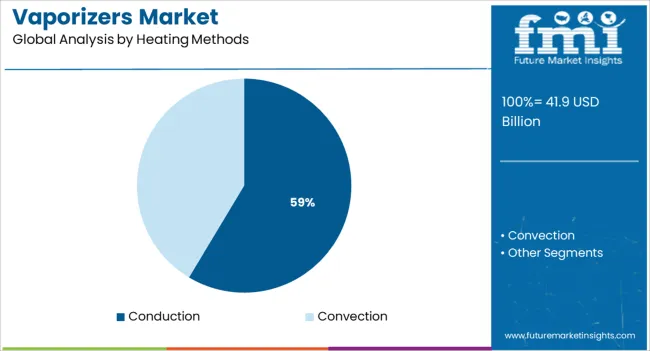
Conduction heating methods are projected to hold a leading 58.6% share of the market in 2025. This dominance is driven by the method’s ability to deliver consistent vapor production through direct heat transfer, resulting in faster activation and simpler device architecture.
Manufacturers have favored conduction-based systems for their cost-effectiveness and ease of maintenance, especially in entry-level and mid-range devices. Advancements in chamber material, such as ceramic and stainless steel, have further enhanced flavor purity and heat efficiency.
The widespread acceptance of conduction vaporizers by both novice and regular users, along with their suitability for both dry herbs and concentrates, has supported strong market penetration. The method’s compatibility with compact designs has also aligned well with growing consumer demand for pocket-sized devices, reinforcing its leadership across product lines.
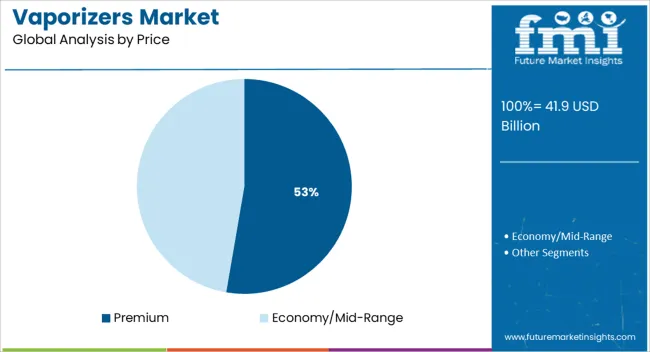
The premium segment is forecast to contribute 52.7% of the market’s revenue in 2025, underscoring its leadership within the price category. This position has been achieved through consumer preference for high-performance devices featuring precision controls, advanced heating systems, and luxury materials.
Premium vaporizers have appealed to users who prioritize quality, safety, and brand reputation, with many devices incorporating smart technology, companion apps, and customizable settings. The rise of health-conscious consumption and the association of vaporizers with wellness and self-care have further supported premium positioning.
Additionally, retailers and direct-to-consumer channels have leveraged upscale branding and design-forward packaging to target discerning consumers. The premium segment continues to benefit from innovation cycles focused on durability, safety certifications, and user personalization, securing its dominant share in the evolving vaporizers landscape.
The main driver of the vaporizer market's expansion is the legalisation of marijuana use and sales. Marijuana use for recreational purposes became legal in Canada, Georgia, Malta, Mexico, South Africa, Thailand and Uruguay. Canada is the second country after Uruguay to legalise marijuana.
Although marijuana is permitted for medical use in the majority of nations, sales will mostly come from marijuana used for recreational purposes. After people become more aware of marijuana's therapeutic benefits, its use as medicine will rise globally.
Marijuana use for medical purposes is now allowed in several nations, considering the substances use illegal for any purpose. The global cannabis market is being propelled by consumers' increased acceptance and desire, which is driving vape sales.
However, the use of marijuana is constrained by severe rules and regulations. Numerous studies have also revealed that using vaporizers can put consumers at serious risk of sickness. Smoking or vaping can be bad for health as, it includes consumption of nicotine, a toxic substance increasing blood pressure and Adrenaline level. Such conditions can lead to heart attack.
Several studies have proved that e-cigarettes are as addictive as traditional ones. Also, some users may purchase extracts which are stronger and have high nicotine content. Increasing voltage of vapes can also give strong effects to users.
All these health concerns have led to ban of vaporizers and e-cigarettes in many countries, restraining the vaporizers market.
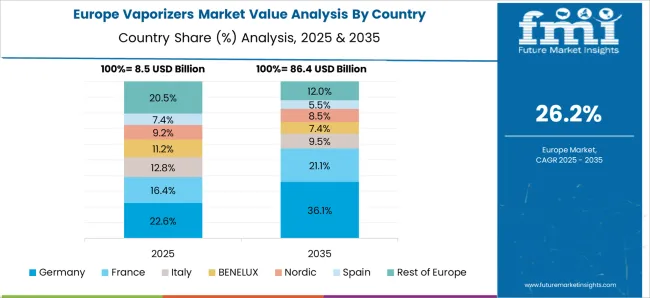
Following a "substantial" increase in sales of innovative heated tobacco products, European Union parliamentarians are recommending a ban on vaping products as portable devices and flavoured liquid cartridges. They claimed this ban will be for protection of youth from addiction from such harmful substances.
As part of a significant anti-cancer campaign, the EU is planning to achieve a Tobacco Free Generation goal, and have no more than 5% of the population using tobacco and other similar products by year 2040. The advent of vaping, however, poses a clear obstacle to preventing young people from smoking with its selection of flavourings that appeal to them, including bubble-gum, crème brûlée, mint, and many more.
Before 2020, there were no laws covering use of e-cigarettes. The already established laws regulating use of tobacco were limited to tobacco products, hence, e-cigarettes were legal and there were no regulations on sell of e-cigarettes and related products. In 2020, vaping was banned in India through Prohibition of Electronic Cigarettes Act, regulating production, import and export, sale and distribution, storage and advertisement of these products.
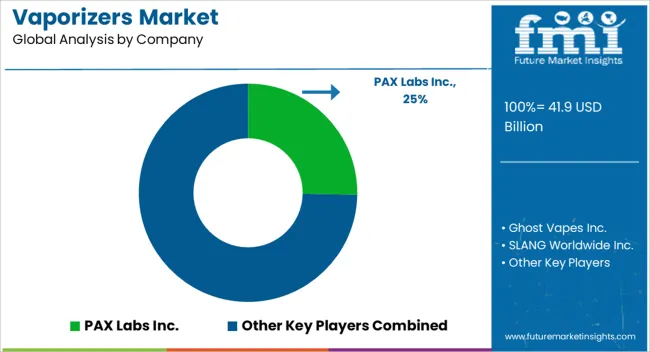
Some key players in the vaporizers market are DaVinci, PAX Labs Inc., Ghost Vapes Inc., SLANG Worldwide Inc., Vapium Inc., STORZ & BICKEL GmbH, Boundless Technology and others. These players are operating in vaporizers market altogether, and introduce new and innovative products to consumers.
| Attribute | Details |
|---|---|
| Growth Rate | CAGR of ~28% from 2025 to 2035 |
| Base year for estimation | 2024 |
| Historical Data Available for | 2020 to 2024 |
| Forecast Period | 2025 to 2035 |
| Quantitative units | Revenue in USD Billion, volume in Units, and CAGR from 2025 to 2035 |
| Report coverage | Revenue forecast, volume forecast, company ranking, competitive landscape, growth factors, and trends, pricing analysis |
| Segments covered | Product Type, Heating Method, Price, Consumable Type, Heat Up Time, Sales Channel, Region |
| Country scope | USA, Canada, Mexico, Germany, UK, France, Italy, Spain, Russia, India, Thailand, China, India, Japan, Australia, Brazil, Argentina, Colombia, Saudi Arabia, UAE, South Africa |
| Key Companies Profiled | DaVinci; PAX Labs Inc.; Ghost Vapes Inc.; SLANG Worldwide Inc.; Vapium Inc.; STORZ & BICKEL GmbH; Boundless Technology; Others |
| Customization scope | Free report customization (equivalent to up to 8 analysts working days) with purchase. Addition or alteration to country, regional & segment scope. |
| Pricing and purchase options | Avail customized purchase options to meet your exact research needs. |
The global vaporizers market is estimated to be valued at USD 41.9 billion in 2025.
The market size for the vaporizers market is projected to reach USD 495.2 billion by 2035.
The vaporizers market is expected to grow at a 28.0% CAGR between 2025 and 2035.
The key product types in vaporizers market are portable, pen style, regular size, desktop, whip style, forced air, e-nail and multifunctional.
In terms of heating methods, conduction segment to command 58.6% share in the vaporizers market in 2025.






Our Research Products

The "Full Research Suite" delivers actionable market intel, deep dives on markets or technologies, so clients act faster, cut risk, and unlock growth.

The Leaderboard benchmarks and ranks top vendors, classifying them as Established Leaders, Leading Challengers, or Disruptors & Challengers.

Locates where complements amplify value and substitutes erode it, forecasting net impact by horizon

We deliver granular, decision-grade intel: market sizing, 5-year forecasts, pricing, adoption, usage, revenue, and operational KPIs—plus competitor tracking, regulation, and value chains—across 60 countries broadly.

Spot the shifts before they hit your P&L. We track inflection points, adoption curves, pricing moves, and ecosystem plays to show where demand is heading, why it is changing, and what to do next across high-growth markets and disruptive tech

Real-time reads of user behavior. We track shifting priorities, perceptions of today’s and next-gen services, and provider experience, then pace how fast tech moves from trial to adoption, blending buyer, consumer, and channel inputs with social signals (#WhySwitch, #UX).

Partner with our analyst team to build a custom report designed around your business priorities. From analysing market trends to assessing competitors or crafting bespoke datasets, we tailor insights to your needs.
Supplier Intelligence
Discovery & Profiling
Capacity & Footprint
Performance & Risk
Compliance & Governance
Commercial Readiness
Who Supplies Whom
Scorecards & Shortlists
Playbooks & Docs
Category Intelligence
Definition & Scope
Demand & Use Cases
Cost Drivers
Market Structure
Supply Chain Map
Trade & Policy
Operating Norms
Deliverables
Buyer Intelligence
Account Basics
Spend & Scope
Procurement Model
Vendor Requirements
Terms & Policies
Entry Strategy
Pain Points & Triggers
Outputs
Pricing Analysis
Benchmarks
Trends
Should-Cost
Indexation
Landed Cost
Commercial Terms
Deliverables
Brand Analysis
Positioning & Value Prop
Share & Presence
Customer Evidence
Go-to-Market
Digital & Reputation
Compliance & Trust
KPIs & Gaps
Outputs
Full Research Suite comprises of:
Market outlook & trends analysis
Interviews & case studies
Strategic recommendations
Vendor profiles & capabilities analysis
5-year forecasts
8 regions and 60+ country-level data splits
Market segment data splits
12 months of continuous data updates
DELIVERED AS:
PDF EXCEL ONLINE
Conduction Vaporizers Market Analysis by Product Type, Heating Material, Sales Channel,End-User and Region 2025 to 2035
Dry Herb Cannabis Vaporizers Market Size and Share Forecast Outlook 2025 to 2035

Thank you!
You will receive an email from our Business Development Manager. Please be sure to check your SPAM/JUNK folder too.
Chat With
MaRIA